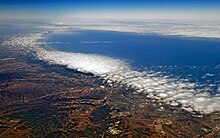Gloom


Gloomis a low level of light which is so dim that there are physiological and psychological effects. Human vision at this level becomesmonochromeand has lessened clarity.
Optical and psychological effects
[edit]Light conditions may be considered gloomy when the level of light in an environment is too low for theproper functionofcone cells,andcolour visionis lost.[1]In a study by Rothwell and Campbell, light levels described as "gloomy" fell between 28 and 3.6cd/m−2.[2]
Low light and lack of color of this sort may be associated withdepressionandlethargy.This association was made as far back as the 2nd century by the ancient Greek physician,Aretaeus of Cappadocia,who said, "Lethargics are to be laid in the light and exposed to the rays of the sun, for the disease is gloom."[3]Also, some studies have found weaker electrical activity in theretinasof depressed people, which gave the individuals studied poorvisual contrast,meaning that they saw the world in grayer hues.[4][5]The naturally weakdaylightduring winter at extreme latitudes can causeseasonal affective disorder(SAD), although a percentage of people experience SAD during summer.[6][7]Asolariumor other source of bright light may be used aslight therapyto treat winter SAD.[3]
Architecture and ergonomics
[edit]Whereartificial lightingis used, this has to be sufficient to not only illuminate the task area, but also provide sufficient background lighting to avoid a sensation of gloominess which has a negative effect on efficiency.[8][9][10]If the task is challenging, such as playingcricket,reaction timesare found to increase significantly when the illumination declines to thegloom level.[11]
In architecture, the level of lighting affects whether a building is considered to be unappealing. If there is little or no sunlight or view of the outdoor surroundings from within, then this will tend to make the building seem "gloomy". As seen from the exterior, an interior which is brighter than the surrounding light level may cause the overall building to seem gloomy because the normal cues and contrasts have been upset.[12]
Artistic effect
[edit]
In the arts, a gloomy landscape or setting may be used to illustrate themes such asmelancholyorpoverty.[13]Horace Walpolecoined the termgloomthto describe the ambiance of great ancient buildings which he recreated in theGothic revivalof his house,Strawberry Hill,and novel,The Castle of Otranto.[14]Characters which exemplify a gloomy outlook includeEeyore,MarvinandOld Man Gloom.[15][16][17]The catchphrase "doom and gloom", which is commonly used to express extremepessimism,was popularised by the movieFinian's Rainbowin which theleprechaunOg (Tommy Steele) uses it repeatedly.[18]
Weather
[edit]
Gloomy conditions may arise when lowcloud coverforms a continuousovercast.This occurs annually inSouthern California,where it is known asJune Gloom.Anticyclonesmay generate gloom-like conditions if they remain stationary, causing ahazeand layer ofstratocumulusclouds. These tend to occur intemperatewinter at themiddle latitudesor over an extended period insubtropicalregions.[19][20]
References
[edit]- ^Susan E. Rothwell; Fergus W. Campbell (1987),"The physiological basis for the sensation of gloom",Ophthalmic and Physiological Optics,7(2): 161–163,doi:10.1111/j.1475-1313.1987.tb01014.x,PMID3658441,S2CID2790271,archived fromthe originalon 2013-01-05
- ^Tiiler, D; Veltch, J (1995)."Perceived room brightness: Pilot Study on the effect of luminance distribution"(PDF).Lighting Research & Technology.27(2): 93–101.doi:10.1177/14771535950270020401.S2CID43479815.
- ^abJohn M. Eagles (2003), "Seasonal affective disorder",British Journal of Psychiatry,182(2): 174–176,doi:10.1192/bjp.182.2.174,PMID12562753
- ^Hannah Devlin (July 21, 2010),"The world truly a grey place for the depressed",Evening Herald
- ^Emanuel Bubla; Elena Kerna; Dieter Eberta; Michael Bachab; Ludger Tebartz van Elsta (15 July 2010),"Seeing Gray When Feeling Blue? Depression Can Be Measured in the Eye of the Diseased",Biological Psychiatry,68(2): 205–208,doi:10.1016/j.biopsych.2010.02.009,PMID20359698,S2CID10321851
- ^Ivry, Sara (August 13, 2002),Seasonal Depression can Accompany Summer Sun,The New York Times,Retrieved September 6, 2008
- ^Seasonal affective disorder (SAD): Symptoms,MayoClinic, (September 22, 2011), Retrieved on March 24, 2013
- ^AJ Shepherd; WG Julian; AT Purcell (1989), "Gloom as a psychophysical phenomenon",Lighting Research and Technology,21(3): 89–97,doi:10.1177/096032718902100301,S2CID110512746
- ^Hubert Claude Weston (1949),Sight, light, and efficiency,H. K. Lewis & Co. Ltd.
- ^AJ Shepherd; WG Julian; AT Purcell (1992), "Measuring appearance: Parameters indicated from gloom studies",Lighting Research and Technology,24(4): 203–214,doi:10.1177/096032719202400404,S2CID109295346
- ^Fergus W. Campbell; Susan E. Rothwell; Michael J. Perry (19 Dec 2007),"Bad light stops play",Ophthalmic and Physiological Optics,7(2): 165–167,doi:10.1111/j.1475-1313.1987.tb01015.x,PMID3658442,S2CID145240361[dead link]
- ^W. M. C. Lam; C. H. Ripman (1992),Perception and lighting as formgivers for architecture,Van Nostrand Reinhold, pp. 24, 54,ISBN978-0-442-01117-8
- ^HD Rodee (1977), "The" Dreary Landscape "as a Background for Scenes of Rural Poverty in Victorian Paintings",Art Journal,36(4): 307–313,doi:10.2307/776087,JSTOR776087
- ^Hugh Walpole (November 2006),The Old Ladies,Read Books,ISBN9781406716788
- ^Delahunty, Andrew; Dignen, Sheila; Stock, Penny (2001),The Oxford dictionary of allusions,Oxford University Press, p. 299,ISBN9780198600312
- ^Darren Harris-Fain (2002),British fantasy and science-fiction writers since 1960,Gale, p. 5,ISBN9780787660055
- ^Jennifer Dewey; Jeanie Puleston Fleming (2004),Zozobra!: The Story of Old Man Gloom,UNM Press,ISBN9780826332790
- ^Eric Partridge; Paul Beale (1986),A dictionary of catch phrases,Routledge, p. 115,ISBN9780415059169
- ^Allaby, Michael (2002). "Anticyclonic gloom".Encyclopedia of Weather and Climate.Vol. 1. Facts on File. p. 34.ISBN978-0-8160-4071-1.
- ^McIlveen, J. F. Robin (1998).Fundamentals of Weather and Climate.Routledge. p. 393.ISBN978-0-7487-4079-6.
